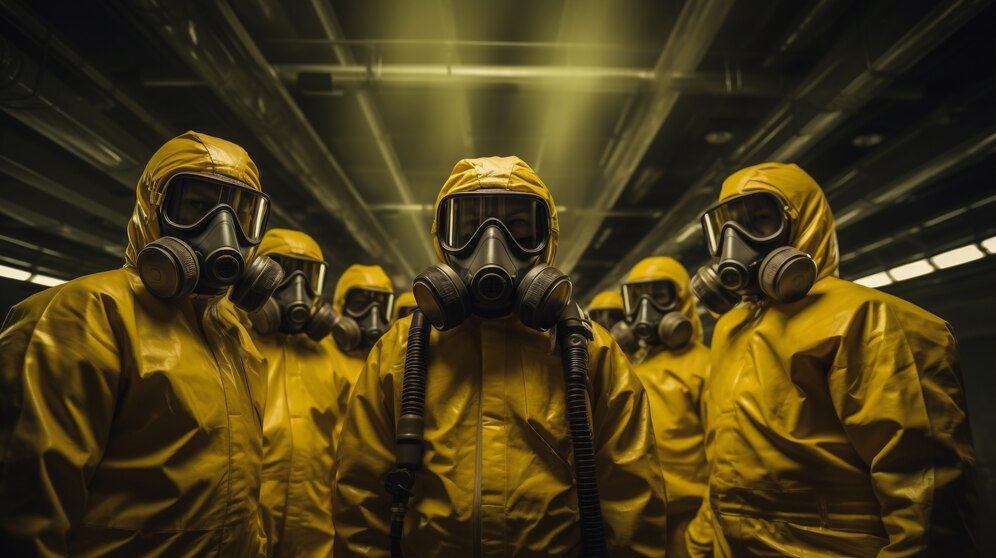In an increasingly complex and interconnected world, the threat of exposure to hazardous materials looms large. Whether it’s responding to chemical spills, combating biological threats, or navigating radioactive environments, the need for robust protective gear is paramount. At the forefront of this defense is the Hazmat suit, a vital piece of personal protective equipment (PPE) designed to shield individuals from a myriad of dangers. In this comprehensive guide, we delve into the intricacies of Hazmat suits, exploring their construction, applications, and the pivotal role they play in safeguarding lives.
Understanding Hazmat Suits
Hazmat suits, short for hazardous materials suits, are specialized garments engineered to provide complete protection against a wide range of hazardous substances. These substances may include chemicals, biological agents, and radioactive materials, among others. Unlike conventional protective clothing, Hazmat suits are impermeable, preventing the penetration of harmful substances through the fabric.
Construction of Hazmat Suits
Material Composition
Hazmat suits are typically crafted from high-quality materials that offer resistance to penetration by hazardous substances. Common materials include:
Polyethylene: Known for its durability and impermeability, polyethylene is frequently used in the construction of Hazmat suits.
Tyvek: This lightweight, breathable material provides a barrier against particles down to 1 micron in size, making it ideal for protection against biological threats.
Butyl Rubber: Offering excellent resistance to chemicals and gases, butyl rubber is often employed in suits designed for hazardous chemical environments.
Polyvinyl Chloride (PVC): PVC-coated suits are resistant to a wide range of chemicals and are commonly used in industrial settings.
Seams and Closure Systems
The seams of Hazmat suits are critical points of vulnerability, as they can allow hazardous substances to penetrate the garment. To mitigate this risk, suits are equipped with sealed seams, typically achieved through techniques such as heat sealing or adhesive bonding.
Closure systems, such as zippers, flaps, and self-sealing closures, ensure a secure fit and further reduce the risk of exposure.
Design Features
Hazmat suits may feature additional design elements to enhance protection and comfort, including:
Integrated gloves and boots: These eliminate the need for separate protective gear and ensure seamless coverage.
Hood with integrated respirator: Some suits incorporate a hood equipped with a built-in respirator, providing respiratory protection without the need for a separate mask.
Reinforced knee and elbow pads: These enhance durability and allow for greater flexibility and mobility in challenging environments.
Applications of Hazmat Suits
Emergency Response
Hazmat suits are integral to the arsenal of emergency responders, including firefighters, paramedics, and hazardous materials (HAZMAT) teams. These professionals rely on Hazmat suits to safely contain and mitigate chemical spills, leaks, and other hazardous incidents.
In the event of a chemical, biological, radiological, or nuclear (CBRN) incident, Hazmat suits equipped with self-contained breathing apparatus (SCBA) provide responders with the necessary protection and respiratory support to operate in contaminated environments.
Industrial Settings
Industries such as chemical manufacturing, pharmaceuticals, and nuclear power generation pose inherent risks of exposure to hazardous materials. Workers in these environments rely on Hazmat suits to safeguard against chemical splashes, airborne contaminants, and other occupational hazards.
Hazmat suits are also utilized during hazardous material handling, decontamination procedures, and maintenance activities in industrial facilities.
Healthcare and Laboratory Settings
Healthcare workers and laboratory personnel handling infectious agents, toxins, and other hazardous materials rely on Hazmat suits to prevent exposure and contamination. These suits play a crucial role in preventing the transmission of diseases and ensuring the safety of both healthcare workers and patients.
During outbreaks of infectious diseases or in research settings, Hazmat suits equipped with biohazard protection offer an additional layer of defense against biological hazards.
Environmental Cleanup and Remediation
Hazmat suits are essential for personnel involved in environmental cleanup and remediation efforts, such as the decontamination of hazardous waste sites or the cleanup of oil spills. These suits enable workers to safely handle and remove hazardous substances while minimizing environmental impact.
Defense and Security
Military and law enforcement personnel may utilize Hazmat suits in response to chemical or biological threats, whether in combat scenarios or during security operations. These suits provide protection against weaponized agents and allow personnel to operate effectively in hostile environments.
Challenges and Considerations
While Hazmat suits offer critical protection against hazardous materials, several challenges and considerations must be addressed to ensure their effectiveness and usability:
Comfort and Mobility
Hazmat suits can be bulky and restrictive, impairing the wearer’s mobility and comfort, particularly during prolonged use. Design innovations focused on ergonomics and breathability are essential to enhance wearer comfort and mobility without compromising protection.
Heat Stress and Dehydration
Wearing a Hazmat suit can lead to heat stress and dehydration, especially in hot and humid environments. Integrated cooling systems, hydration packs, and breathable fabrics can help mitigate these risks and ensure wearer comfort during extended wear.
Training and Maintenance
Proper training in the selection, donning, doffing, and decontamination of Hazmat suit’s is essential to ensure user safety and effectiveness. Regular inspection, maintenance, and replacement of suits and components are also critical to prevent degradation and ensure reliable performance.
Compatibility with Other Equipment
Hazmat suit’s must be compatible with other protective equipment, such as respiratory protection devices, communication systems, and personal monitoring devices. Integration of these components and seamless interoperability are essential for effective operation in hazardous environments.
Conclusion
Hazmat suit’s are indispensable tools for safeguarding lives and minimizing the risks associated with exposure to hazardous materials. From emergency responders and industrial workers to healthcare professionals and military personnel, individuals operating in hazardous environments rely on Hazmat suit’s to provide essential protection against a wide range of threats. As technology advances and new hazards emerge, ongoing innovation and investment in Hazmat suit design and development are crucial to ensure the safety and resilience of those on the front lines of hazard response and containment.







